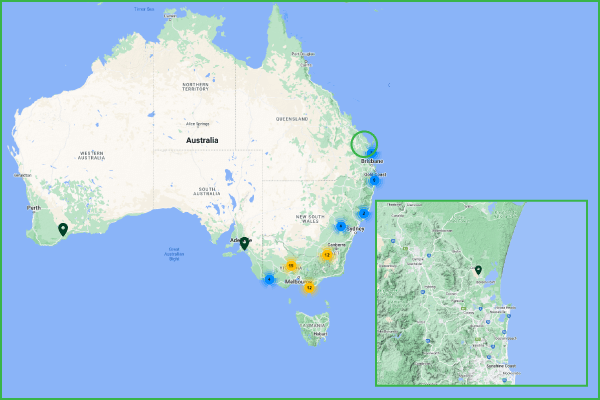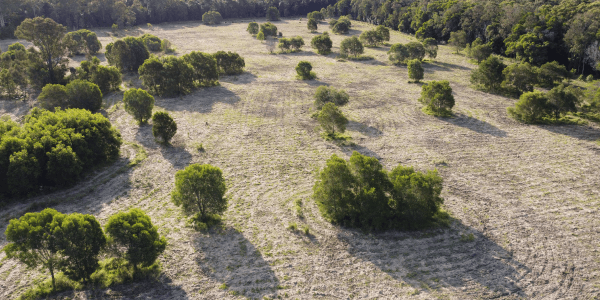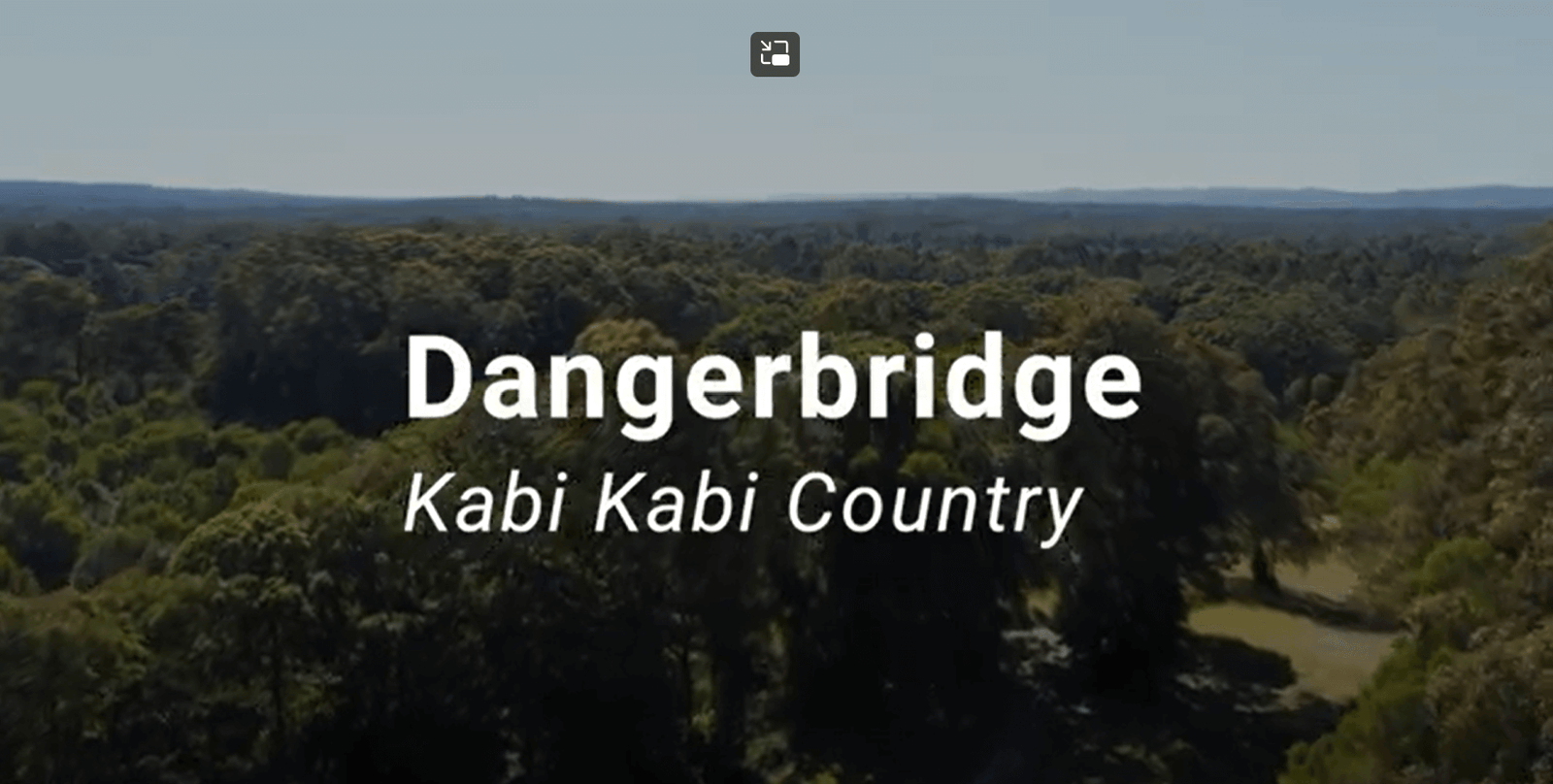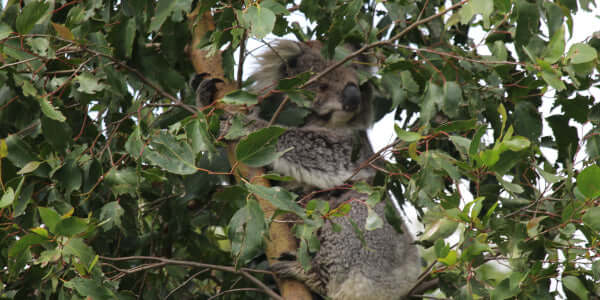A Long Term Approach To Habitat Restoration
Located north of Queensland’s iconic Noosa region, the project at Dangerbridge is delivering critical climate action and providing a haven for koalas and birdlife. On land Traditionally Owned by the Kabi Kabi people, custodians of Queensland’s Sunshine Coast, our revegetation work is returning the land to native forest.
Greenfleet has been working with landholder Jeni Nicholas to revegetate her property to native forest since 2003. Jeni was motivated to transform the property to support the region’s wildlife, in particular to extend habitat for native birds.

Location & Map
Located north of Noosa and just west of Lake Cootharaba on the Sunshine Coast, this property spans over 90 hectares. Nearly 90% of the property has now been restored to native forest to improve the site’s biodiversity and allow wildlife and birdlife to thrive.
History
The land on which Dangerbridge sits had been cleared for agriculture and farming. While there was some existing forest surrounding the property, most of the site had been cleared of vegetation.
When Jeni purchased the property, pockets of remnant forest remained, and were being actively used by native birds in the region. This motivated Jeni to extend the vegetation. Greenfleet’s Revegetation Team identified the native species needed to transform the property and encourage more local wildlife to return.
Jeni’s vision came to life in 2003 when Greenfleet planted 17,000 native trees across 19 hectares of the property. Together with Jeni, Greenfleet selected 30 native species for the initial planting including Forest Red Gum (Eucalyptus tereticornis) in the forest canopy, which is an important koala food source.
After 10 years, some of the canopy species in this initial planting reached 20 metres in height and formed habitat for many native bird species. At the time, Jeni reflected on the positive impact being made saying “the resulting forest is fantastic. I'm so pleased with the outcome."
The continued alignment between Greenfleet’s focus on ecosystem restoration, and Jeni’s vision for her property meant we returned in 2021 to plant over 120,000 further native trees. Now, nearly 140,000 native trees make up the biodiverse forest that is growing across 77 hectares of the property.

Planting Approach & Species Selection
Greenfleet worked with Jeni on a unique approach to the site preparation. To reduce the weeds and to help ensure water filtration in the heavily compacted soil, a process called discing was used, which reduces soil compaction in preparation for planting.
Aquaspears, a planting tool that uses pressurised water to hydrate the soil, were used to ensure the seedlings would retain water for up to three weeks after they were initially planted. Together, these processes helped the native seedlings to thrive regardless of the region’s rainfall.
In line with Greenfleet’s Queensland planting season, the revegetation work occurred in the early months of the year. Across the plantings in 2003 and 2021, a wide variety of native species were selected to propel the planting into a biodiverse wildlife haven.
Some of the species planted include Weeping Bottle Brush (Callistomon viminalis), Southern Silky Oak (Grevillea robusta), and Paperbarked Tea Tree (Melaleuca quinquenervia) which is an important species for native birds such as Honeyeaters and Lorikeets. See a full list of planted species at the bottom of this page.
Restoring Koala Habitat
One of the key environmental goals of this project has been to establish protected habitat for the region’s koalas. Koala populations in Queensland, New South Wales and the ACT were reclassified to endangered in 2022, making projects like this more important than ever.
By selecting species such as Forest Red Gum (Eucalyptus tereticornis), a vital food and habitat tree for these animals, the aim is that koala populations can utilise this forest into the future. The 2021 planting at Dangerbridge was part of more than 120 hectares of koala habitat that Greenfleet restored across the eastern states of Australia in that year.
In 2021, Noosa Landcare and QTFN worked to release a young koala, Billi, into the native forest at Dangerbridge. Billi will be able to find a long-term home in this protected forest. You can watch Billi’s story in the video below.
Traditional Owners
Dangerbridge grows on land traditionally owned by the Kabi Kabi people. Kabi Kabi Country runs along the Sunshine Coast from north of Brisbane to the Gregory and Isaac Rivers south of Bundaberg.
Kabi Kabi people were heavily impacted by laws instigated by the Australian and Queensland Governments which saw the forced removal from their Country to missions such as Cherbourg. The impacts of this are still being felt by their community today.
Greenfleet works closely with the Kabi Kabi people on another project in the region where we are restoring 1,100 hectares of koala habitat in the Noosa Hinterland. In 2021, Greenfleet signed a landmark Indigenous Land Use Agreement with the Kabi Kabi Peoples Aboriginal Corporation, the first of its kind to be established between an environmental organisation and Traditional Owners.
Climate Action In Queensland
Dangerbridge is one of Greenfleet’s many revegetation projects currently underway in Queensland. From South-East Queensland to Bundaberg, Greenfleet has nearly 30 forests growing in this region and over 550 forests in total across Australia and New Zealand.
While this project has important habitat outcomes for the region’s wildlife, it will also deliver climate action across its lifetime. By removing 102,000 tonnes of CO2-e from the atmosphere, this forest is playing a vital role in helping our environment. This is the equivalent carbon that over 23,720 vehicles emit on our roads in a year.
Partners
Greenfleet is committed to collaborative relationships with partners also committed to making a long-term difference for our environment and climate. The project at Dangerbridge is a collective effort between Greenfleet, Noosa District Landcare Group and Queensland Trust for Nature.
Noosa District Landcare Group is committed to achieving long-term environmental outcomes. They provide a diverse range of services including ecosystem restoration, native forest establishment and environmental property consultancy.
Queensland Trust for Nature restores, enhances, and protects biodiversity, habitat for threatened species and ecosystems across Queensland through sustainable land management, smart investment strategies, powerful partnerships, and proven results.
About Greenfleet
Greenfleet is a leading environmental not-for-profit organisation protecting our climate by restoring our forests. As Australia’s first carbon offset provider, Greenfleet has been delivering climate action for over 25 years. Since 1997 Greenfleet has:
- planted over 11.2 million native trees
- created 550+ legally protected forests
- restored 11,000 hectares of land
- offset 5 million tonnes of CO2-e
While delivering climate action by removing carbon from the atmosphere, the forests that Greenfleet restores also provide a wealth of additional environmental benefits. From creating habitat for vulnerable wildlife, to improving the health of our soils and waterways, Greenfleet’s revegetation projects are playing an important role in restoring healthy and resilient ecosystems across landscapes in Australia and New Zealand.
The forests restored by Greenfleet are legally protected by an on-title agreement for up to 100 years from the time they are planted. This means that the trees are given the best chance to grow into well established, old-growth forests. This protection remains in place even if the land were to change owners.
Greenfleet is fully funded by corporate and individual supporters who offset their emissions or make contributions to restore native wildlife habitat. Over the last 25 years, thousands of like-minded supporters have joined Greenfleet to take practical action on climate change.
You can see where all of Greenfleet’s revegetation projects are growing via our interactive map and to become a Greenfleet supporter, click here.
Location Size
92 hectares north of Noosa on Kabi Kabi Country
Planting Dates
2003, 2021, 2023
Species
- Acacia disparrima subsp. Disparrima
- Acacia maidenii
- Acacia melanoxylon
- Acacia oshanesii
- Allocasuarina littoralis
- Alphitonia excelsa
- Angophora subvelutina
- Araucaria cunninghamii
- Casuarina glauca
- Callistomon viminalis
- Callistomon viridis
- Callitris
- Commersonia bartramia
- Corymbia gummifera
- Corymbia intermedia
- Eucalyptus tereticornis
- Eucalyptus grandis
- Eucalyptus microcorys
- Eucalyptus propinqua
- Eucalyptus robusta
- Ficus watkinsiana
- Ficus obliqua
- Flindersia australis
- Grevillea robusta
- Gmelina leichhardtii
- Lophostemon confertus
- Melaleuca quinquenervia
- Melaleuca saligna
- Melaeuca vimanilis
- Syncarpia glomulifera
- Toona ciliata
- Allocasuarina torulasa
- Corymbia glauca
- Corymbia tesselaris
- Eucalyptus resinifera
- Lophostemon suaveolans




